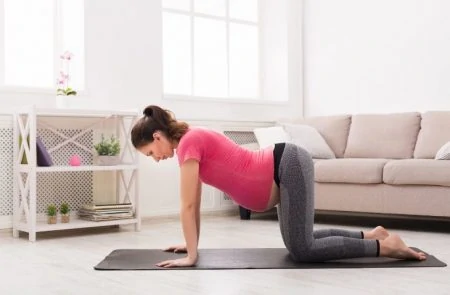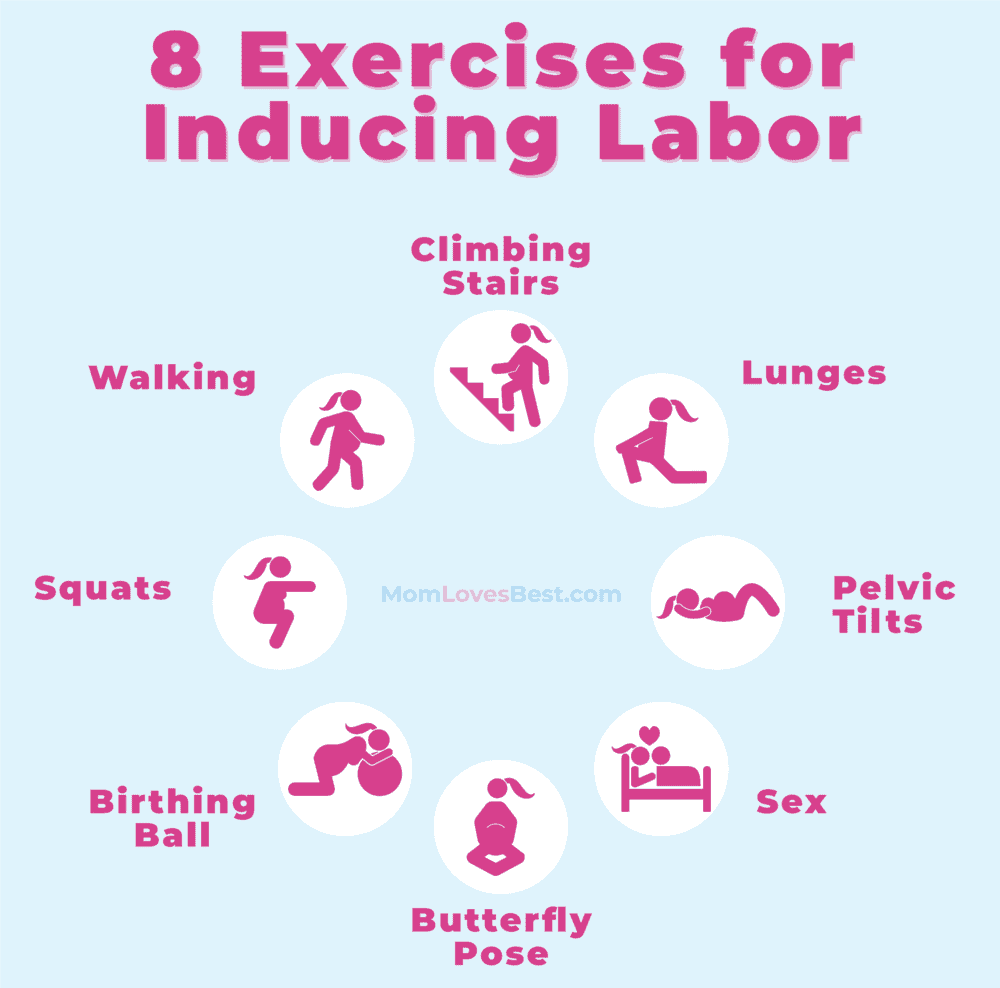Are you officially past your due date and looking for ways to get things moving without a medical induction?
Waiting for your baby to make their grand entrance is tough. While most babies arrive on their own timeline, some need a little extra encouragement. If you are eager to meet your little one, getting active can help align your body and coax your baby into the birth canal.
In this guide, we will cover when it is safe to try natural induction, who should avoid exercise, and eight effective activities to help induce labor naturally.
Key Takeaways
- Consult your provider first: Always speak with your OB-GYN or midwife before attempting to induce labor. The safest window is usually between 39 and 41 weeks.
- Safety is priority: While exercise is generally safe, avoid it if you have conditions like placenta previa, pre-eclampsia, or are on prescribed bed rest.
- Gravity helps: Upright exercises like walking, stair climbing, and squatting use gravity to help the baby descend into the pelvis.
- Listen to your body: Do not exhaust yourself. You need to save energy for the actual labor marathon ahead.
When Is it Okay to Try to Induce Labor?
Before you lace up your sneakers, chat with your obstetrician or midwife. Generally, the sweet spot for encouraging labor is between 39 and 41 weeks gestation.
Babies born during this window are considered full-term and typically have better health outcomes (1). Trying to evict your tenant too early can lead to complications with breastfeeding, jaundice, or breathing. Waiting until at least 39 weeks also supports better brain development.
However, if you pass the 42-week mark, your care provider will monitor you closely. Risks like fetal distress, low amniotic fluid, and placenta deterioration increase at this stage (2). This is often when medical induction becomes a necessary discussion.
Most care providers and the ACOG (American College of Obstetricians and Gynecology) recommend at least offering induction and doing a biophysical profile and nonstress test at 41 weeks (3).
Editor's Note:
Caitlin Goodwin, MSN, RN, CNMIf you are facing a potential medical induction due to dates or other risk factors, asking about natural methods first is a great proactive step.
Remember
Who Shouldn’t Use Exercise to Induce Labor?
Regular exercise is fantastic for most pregnancies. However, trying to induce labor through vigorous activity isn’t safe for everyone.
If you have any of the following conditions, skip the workout and consult your doctor immediately:
- Prescribed bed rest.
- Pre-eclampsia or gestational hypertension.
- Severely high or low amniotic fluid levels.
- Placenta previa or placenta accreta.
- History of premature labor.
- A short cervix (cervical insufficiency).
8 Activities to Naturally Induce Labor
If you have the “all clear” from your doctor and you are ready to meet your baby, try these eight activities to help get labor started.
1. Walking and Curb Walking
Walking is the holy grail of natural induction. It keeps you upright, allowing gravity to pull the baby downward against your cervix. This pressure can help efface (thin) and dilate the cervix.
For an extra boost, try “curb walking.” This involves walking with one foot on the sidewalk curb and the other on the road. The uneven gait rocks your pelvis, which can help wiggle the baby into a better position for birth. Walk for a few minutes with one foot up, then switch sides.
Whether you are hitting the local trail or doing laps around the living room, keep a steady pace but don’t overexert yourself.
2. Climbing Stairs
Stair climbing is a fantastic way to open the pelvis. The motion of lifting your leg high helps angle your baby into the birth canal.
When you climb stairs, you naturally tilt your pelvis, which creates more room for the baby’s head to descend. If you feel comfortable, try skipping a step (safely). This wider stance opens the pelvis even further, putting gentle pressure on the cervix. This pressure helps stimulate the release of oxytocin, the hormone responsible for contractions.
Safety First
3. Deep Squats
Squatting is a primal birthing position for a reason. It opens the pelvic outlet by up to 10 percent more than lying down.
Deep squats, often called the “Malasana” pose in yoga, allow gravity to do the heavy work. This position encourages the baby to move lower into the pelvis, which can help kick-start labor.
How to do it:
Stand with feet shoulder-width apart. Lower your hips toward the floor, keeping your back straight and heels flat if possible. Hold for 20 to 30 seconds. If you need support, hold onto a sturdy chair or your partner’s hands.
4. Lunges
Lunges are excellent for warming up the hips and creating room for the baby to rotate. This is particularly helpful if your baby is riding high or hasn’t “dropped” yet.
The technique:
Stand with your feet together. Take a large step forward and drop your back knee toward the ground. Ensure your front knee aligns with your ankle. Hold for 5 to 10 seconds, then push back up.
Lunges create an asymmetrical opening in the pelvis, which is great for navigating a baby through the mid-pelvis. If balance is an issue, ask your doula or partner to spot you.
5. Birthing Ball Exercises
Swap your couch for a birthing ball. Sitting on an exercise ball with your legs wide increases blood flow to the uterus and opens the pelvic outlet.
Motion is key here. Don’t just sit still; try these moves:
- Bouncing: Gentle bounces can help the baby descend.
- Hip Circles: Rotate your hips in wide circles to help the baby navigate the pelvis.
- Figure Eights: Move your hips in a figure-eight motion to loosen tight ligaments.
This is also a great way to relieve lower back pain in late pregnancy.
6. Pelvic Tilts (Cat-Cow)
Pelvic tilts are one of the most gentle and effective ways to encourage optimal fetal positioning. If your baby is “sunny side up” (facing your belly), this exercise encourages them to turn and face your spine, which is ideal for delivery.
The best way to do this is on your hands and knees. In yoga, this is the Cat-Cow flow.
1. Inhale and drop your belly while looking up (Cow).
2. Exhale and arch your back toward the ceiling, tucking your chin (Cat).
3. Repeat this 30 to 40 times a day (4).
7. Butterfly Stretch
Tight hips can sometimes hinder the baby’s descent. The butterfly stretch increases flexibility in the pelvic joints and inner thighs.
Sit on the floor with the soles of your feet touching. Gently press your knees toward the ground using your elbows. Do not force it; just go to where you feel a good stretch. Hold for 15 to 30 seconds.
This simple stretch relaxes the pelvic floor muscles, which need to be soft and yielding for birth to occur.
8. Sex
It might be the last thing on your mind right now, or maybe the first! Either way, sex is one of the most scientifically backed natural induction methods.
Three things happen here:
1. Prostaglandins: Semen contains prostaglandins, hormone-like substances that help soften and ripen the cervix (5).
2. Oxytocin: Orgasms trigger a release of oxytocin, which stimulates uterine contractions.
3. Physical Stimulation: The physical activity itself can help stimulate the lower uterus.
Note: Avoid sex if your water has already broken, as this increases the risk of infection.
Getting Baby into the “Sweet Spot”
Sometimes labor doesn’t start because the baby isn’t in the right position to put pressure on the cervix. This is where “Spinning Babies” concepts come into play.
Focusing on alignment and balance can help your baby engage. In addition to the exercises above, consider these techniques:
- Forward-Leaning Inversion: This temporarily turns your pelvis upside down to untwist ligaments in the lower uterus. Kneel on the edge of a couch and carefully lower your hands to the floor. Hold for 30 seconds. (Safety Note: Do not do this if you have high blood pressure or heartburn issues).
- Rebozo Sifting: Using a long scarf or Rebozo, a partner gently lifts and sifts your belly while you are on your hands and knees. This relaxes the abdominal muscles and gives the baby room to turn.
- Belly Lift: If you have a pendulous belly, lifting it up and in during a contraction can help align the baby with the pelvis.
FAQs
Get Moving (But Rest Too!)
If you are past your due date, moving your body is one of the best ways to feel proactive and physically prepare for birth.
Whether it is bouncing on a ball or taking a long walk with your partner, these exercises can help align your baby and soften your cervix. Just remember: labor is an endurance event. Don’t use up all your energy trying to start it. Balance your activity with plenty of rest and hydration.
Have you tried any of these natural induction methods? Share what worked for you in the comments below!












